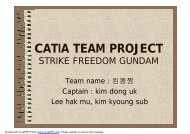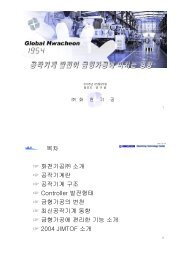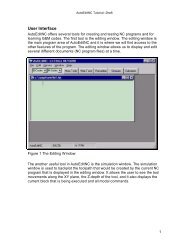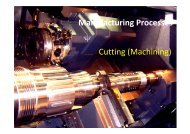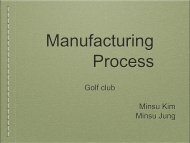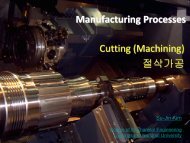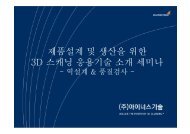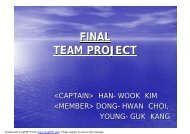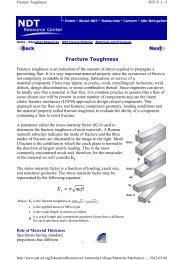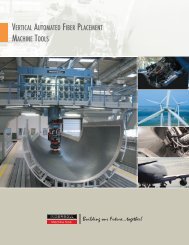Manufacturing Processes Grinding(연삭), E DM DM(방전)
Manufacturing Processes Grinding(연삭), E DM DM(방전)
Manufacturing Processes Grinding(연삭), E DM DM(방전)
You also want an ePaper? Increase the reach of your titles
YUMPU automatically turns print PDFs into web optimized ePapers that Google loves.
<strong>Grinding</strong>, E<strong>DM</strong><br />
<strong>Manufacturing</strong> <strong>Processes</strong><br />
© 2012 Su-Jin Su Jin Kim GNU<br />
<strong>Manufacturing</strong> <strong>Processes</strong><br />
<strong>Grinding</strong>(<strong>연삭</strong><br />
<strong>Grinding</strong> <strong>연삭</strong>), , E<strong>DM</strong> E<strong>DM</strong>(<strong>방전</strong>)<br />
Associate Professor Su-Jin Kim<br />
School of Mechanical Engineering<br />
Gyeongsang National University
Contents<br />
1. Abrasive and mechanics<br />
2. <strong>Grinding</strong><br />
3. E<strong>DM</strong> (Electrical discharge machining)<br />
4. Water Jet Cutting<br />
<strong>Grinding</strong>, E<strong>DM</strong><br />
<strong>Manufacturing</strong> <strong>Processes</strong><br />
© 2012 Su-Jin Su Jin Kim GNU
<strong>Grinding</strong> (<strong>연삭</strong>)<br />
• In grinding, an abrasive material rubs against the metal<br />
part and removes a small amount of material.<br />
• Reasons for grinding are: The material is too hard to be<br />
machined. Tolerance is less than ±0.0025 mm.<br />
<strong>Grinding</strong>, E<strong>DM</strong><br />
<strong>Manufacturing</strong> <strong>Processes</strong><br />
© 2012 Su-Jin Su Jin Kim GNU<br />
©김태용, GNU
Abrasives (<strong>연삭</strong>입자)<br />
• Abrasives are harder than conventional cutting‐tool<br />
materials.<br />
1. Aluminium oxide, Al2O3 2. Silicon carbide, SiC<br />
3. CBN (Cubic boron nitride)<br />
4. PCD (Poly crystal diamond)<br />
• Grit number (입도지수) indicates the size which is a<br />
the function of a sieve(체)size. (10: very rough, 100:<br />
fine, 500 very fine)<br />
<strong>Grinding</strong>, E<strong>DM</strong><br />
<strong>Manufacturing</strong> <strong>Processes</strong><br />
© 2012 Su-Jin Su Jin Kim GNU
<strong>Grinding</strong> wheel (<strong>연삭</strong> 숫돌)<br />
• Abrasive grains are held together by a bonding material<br />
to achieve a high material removal rate.<br />
• Bond types (결합제): ceramic bond, plastic based bond,<br />
rubber, metal bonds<br />
<strong>Grinding</strong>, E<strong>DM</strong><br />
<strong>Manufacturing</strong> <strong>Processes</strong><br />
© 2012 Su-Jin Su Jin Kim GNU
Mechanics of <strong>Grinding</strong> (<strong>연삭</strong>이론)<br />
• Cutting tool is an individual irregular abrasive grain<br />
• The average rake angle of the grains is highly negative<br />
• Cutting speeds of grinding wheels are very high<br />
• Power = Specific energy x MRR (material removal rate)<br />
<strong>Grinding</strong>, E<strong>DM</strong><br />
<strong>Manufacturing</strong> <strong>Processes</strong><br />
© 2012 Su-Jin Su Jin Kim GNU<br />
Chip<br />
ф<br />
Workpiece<br />
α<br />
Grain<br />
v<br />
Material Specific energy<br />
(GPa, J/mm 3 )<br />
Aluminum 7~27<br />
Cat iron 12‐60<br />
Low carbon steel 14‐68<br />
Tool steel 18‐82
Temperature<br />
• Most of the cutting power transfers into heat.<br />
• Temperature rise affects the surface properties and<br />
causes residual stress on the workpiece.<br />
• Use fluid to prevent excessive temperature rise and to<br />
improve the surface finish and dimensional accuracy.<br />
<strong>Grinding</strong>, E<strong>DM</strong><br />
<strong>Manufacturing</strong> <strong>Processes</strong><br />
© 2012 Su-Jin Su Jin Kim GNU<br />
http://www.youtube.com/watch?v=Nn8j3hp_z6M CNC grinding, Dressing, Coolant
<strong>Grinding</strong> Wheel Wear (<strong>연삭</strong>숫돌마멸)<br />
• Attritious wear(소모마멸): caused by interaction of grain and<br />
workpiece<br />
• Grain fracture(입자파괴): caused by excessive attritious wear,<br />
Friability is the ability of an abrasive grain to fracture into<br />
smaller pieces.<br />
• Bond fracture(결합재파괴): if bond is too Grain strong, dull grains<br />
<strong>Grinding</strong>, E<strong>DM</strong><br />
<strong>Manufacturing</strong> <strong>Processes</strong><br />
© 2012 Su-Jin Su Jin Kim GNU<br />
cannot be dislodged<br />
Bond<br />
Bond fracture<br />
Porosity<br />
Wear<br />
Micro crack<br />
Grain fracture
Dressing<br />
• Once the sharp edges of the grinding wheel are worn<br />
out, they need to be dressed.<br />
• <strong>Grinding</strong> dressers are used for making different profile<br />
on grinding wheel. The dressing of a wheel in order to<br />
return the wheel to its original shape.<br />
<strong>Grinding</strong>, E<strong>DM</strong><br />
http://www.ehow.com/video_4418709_dressing-grinding-wheel-sharpening-tools.html Dressing<br />
<strong>Manufacturing</strong> <strong>Processes</strong><br />
© 2012 Su-Jin Su Jin Kim GNU<br />
vitrified bonded dressing tools single grit diamond dressing tools
Surface grinding (평면<strong>연삭</strong>)<br />
• Surface grinding involves grinding flat surfaces.<br />
<strong>Grinding</strong>, E<strong>DM</strong><br />
http://ma.gnu.ac.kr/vod/Machining/<strong>Grinding</strong>_Machine.MP4 Surface grinding machine<br />
<strong>Manufacturing</strong> <strong>Processes</strong><br />
© 2012 Su-Jin Su Jin Kim GNU<br />
<strong>Grinding</strong> wheel<br />
25~50 m/s<br />
Workpiece<br />
0.2~1 m/s<br />
Small depth<br />
0.01~0.05 mm
Cylindrical grinding (원통<strong>연삭</strong>)<br />
• Cylindrical grinding, internal grinding and thread<br />
grinding are done on cylindrical grinders or centerless<br />
grinders<br />
<strong>Grinding</strong>, E<strong>DM</strong><br />
<strong>Manufacturing</strong> <strong>Processes</strong><br />
© 2012 Su-Jin Su Jin Kim GNU<br />
<strong>Grinding</strong> wheel<br />
Workpiece
Centerless & Creep‐feed grinding<br />
• Centerless grinding<br />
• Creep‐feed grinding : low feed, large depth<br />
<strong>Grinding</strong>, E<strong>DM</strong><br />
<strong>Manufacturing</strong> <strong>Processes</strong><br />
© 2012 Su-Jin Su Jin Kim GNU<br />
<strong>Grinding</strong><br />
wheel<br />
Work-rest<br />
blade<br />
Regulating<br />
wheel<br />
Large depth<br />
1~6 mm<br />
Low speed<br />
0.1~1 m/min
Ex) Forces in surface grinding<br />
Assume that you are performing a surface-grinding operation on a low-carbon steel<br />
workpiece using a wheel of diameter D = 25.4 cm that rotates at N = 4000 rpm.<br />
The width of cut is w = 2.54 cm, depth of cut is d = 0.00508 cm, and the feed rate<br />
of the workpiece is v = 152.4 cm/min. Calculate F c and F n .<br />
Solution<br />
Material removal rate is<br />
Power consumed is<br />
Power<br />
uMMR 682. 5811.<br />
966<br />
1342<br />
W 6.1183<br />
kg - m/min 8210.<br />
76 m - kg/min<br />
<strong>Grinding</strong>, E<strong>DM</strong><br />
<strong>Manufacturing</strong> <strong>Processes</strong><br />
© 2012 Su-Jin Su Jin Kim GNU<br />
MRR<br />
dwv<br />
<br />
3<br />
0. 005082.<br />
54152.<br />
4<br />
1.<br />
966 cm /min
Ex) Forces in surface grinding<br />
Solution<br />
Since power is defined as<br />
Since thrust force is about 30% higher than the cutting force,<br />
<strong>Grinding</strong>, E<strong>DM</strong><br />
<strong>Manufacturing</strong> <strong>Processes</strong><br />
© 2012 Su-Jin Su Jin Kim GNU<br />
Power T<br />
8210.<br />
76<br />
Fn<br />
F<br />
<br />
c<br />
25.<br />
4 <br />
Fc<br />
<br />
2 <br />
25.<br />
8 kg<br />
24000 1. 325.<br />
8<br />
33.<br />
54 kg
Finishing Operations (마무리작업)<br />
1. Coated abrasives (Sandpaper) is used<br />
in finishing flat or curved surfaces of<br />
metallic and non‐metallic parts. Surface<br />
finish depends primarily on grain size.<br />
2. Wire brushing produces a fine surface<br />
texture and serves as a light material‐<br />
removal process.<br />
3. Lapping & polishing: Two surfaces are<br />
rubbed together with an abrasive<br />
between them to creates a smooth and<br />
shiny surface<br />
<strong>Grinding</strong>, E<strong>DM</strong><br />
<strong>Manufacturing</strong> <strong>Processes</strong><br />
© 2012 Su-Jin Su Jin Kim GNU
Finishing Operations<br />
4. Honing: Abrasive stone scrubs metal<br />
woekpiece to improve a surface texture.<br />
http://www.youtube.com/watch?v=f6CEkkG-j8s&p=9B6D9EAE75875D9D Honing engine block<br />
<strong>Grinding</strong>, E<strong>DM</strong><br />
<strong>Manufacturing</strong> <strong>Processes</strong><br />
© 2012 Su-Jin Su Jin Kim GNU
Ultrasonic Machining (초음파가공)<br />
• Material is removed from the workpiece surface by the<br />
process of microchipping with abrasive particles with<br />
vibrations between the tool and the surface of the<br />
workpiece.<br />
<strong>Grinding</strong>, E<strong>DM</strong><br />
<strong>Manufacturing</strong> <strong>Processes</strong><br />
© 2012 Su-Jin Su Jin Kim GNU<br />
Power<br />
supply Transducer<br />
Tool<br />
Workpiece<br />
Abras<br />
slurry<br />
©갈창우, GNU<br />
http://ma.gnu.ac.kr/vod/machining/Ultrasonic_Machining.MP4 Ultrasonic Knife
ECM (Electrochemical Machining, 전해가공)<br />
• High rate of electrolyte movement washes metal<br />
ions away from the workpiece.<br />
• It is used for machining extremely hard conductive<br />
materials with soft tool.<br />
Insulating<br />
coating<br />
Workpiece<br />
<strong>Grinding</strong>, E<strong>DM</strong><br />
<strong>Manufacturing</strong> <strong>Processes</strong><br />
© 2012 Su-Jin Su Jin Kim GNU<br />
DC<br />
power<br />
supply<br />
(+)<br />
(-)<br />
Pump for<br />
circulating<br />
electrolyte<br />
Tool electrode<br />
Tank<br />
Electrolyte<br />
©갈창우, GNU<br />
http://www.youtube.com/watch?v=Z_U_ZZty5Ns
Electrochemical <strong>Grinding</strong> (전해<strong>연삭</strong>)<br />
• Combines the processes of electrochemical machining<br />
and conventional grinding.<br />
<strong>Grinding</strong>, E<strong>DM</strong><br />
<strong>Manufacturing</strong> <strong>Processes</strong><br />
© 2012 Su-Jin Su Jin Kim GNU
E<strong>DM</strong> (Electrical‐Discharge Machining, <strong>방전</strong>가공)<br />
• Based on erosion of metals by spark discharges.<br />
• E<strong>DM</strong> system consists of electrodes(전극) connected to<br />
a DC and placed in a dielectric fluid(<strong>방전</strong>액).<br />
• 50~380 V, 0.1~500 A, 50~500 kHz, 1~100 μm3 /Hz<br />
<strong>Grinding</strong>, E<strong>DM</strong><br />
<strong>Manufacturing</strong> <strong>Processes</strong><br />
© 2012 Su-Jin Su Jin Kim GNU<br />
Spark<br />
http://www.youtube.com/watch?v=q4FinKsDfww E<strong>DM</strong><br />
Electrode<br />
Workpiece
E<strong>DM</strong> (Electrical‐Discharge Machining)<br />
• Usedto machine high hardness metals like as die by<br />
copper of graphite electrode.<br />
• Metal removal rate (mm 3 /min) = Exp const x Current (A)<br />
/ Meting temperature (°C): MRR = 4x10 4 I T w ‐1.23<br />
<strong>Grinding</strong>, E<strong>DM</strong><br />
<strong>Manufacturing</strong> <strong>Processes</strong><br />
© 2012 Su-Jin Su Jin Kim GNU<br />
http://ma.gnu.ac.kr/vod/Machining/E<strong>DM</strong>.WMV Machine
Wire E<strong>DM</strong>( Wire Electric Discharge Machining)<br />
• A brass wire is fed through the workpiece submerged in<br />
a tank of dielectric fluid.<br />
• It is used to cut plates as thick as 0.3 m and to make<br />
punches, tools, and dies from hard metals.<br />
+ Workpiece<br />
<strong>Grinding</strong>, E<strong>DM</strong><br />
<strong>Manufacturing</strong> <strong>Processes</strong><br />
© 2012 Su-Jin Su Jin Kim GNU<br />
- Wire electrode<br />
http://www.youtube.com/watch?v=pBueWfzb7P0 WireE<strong>DM</strong><br />
http://ma.gnu.ac.kr/vod/Machining/WireE<strong>DM</strong>.wmv WireE<strong>DM</strong>
Small Hole E<strong>DM</strong><br />
•E<strong>DM</strong> drill rows of holes into the leading and trailing<br />
edges of turbine blades used in jet engines.<br />
<strong>Grinding</strong>, E<strong>DM</strong><br />
<strong>Manufacturing</strong> <strong>Processes</strong><br />
© 2012 Su-Jin Su Jin Kim GNU
Water‐Jet Cutting<br />
• Water jet acts like a saw and cuts the material.<br />
• Advantages: start at any location, no heat, no deflection,<br />
environmentally friendly.<br />
<strong>Grinding</strong>, E<strong>DM</strong><br />
<strong>Manufacturing</strong> <strong>Processes</strong><br />
© 2012 Su-Jin Su Jin Kim GNU<br />
5-axis: http://www.youtube.com/watch?v=2jm4_HikMqk&p=9B6D9EAE75875D9D
Abrasive‐Jet Cutting<br />
Abrasive water‐jet cutting<br />
• The water jet contains abrasive particles and increases<br />
the material removal rate.<br />
• Various thicknesses can be cut in single or multiple<br />
layers.<br />
Abrasive‐jet cutting<br />
• High‐velocity jet is aimed at a surface under controlled<br />
conditions.<br />
<strong>Grinding</strong>, E<strong>DM</strong><br />
<strong>Manufacturing</strong> <strong>Processes</strong><br />
© 2012 Su-Jin Su Jin Kim GNU<br />
Abrasive waterjet: http://www.youtube.com/watch?v=GCBsTumaIhs



